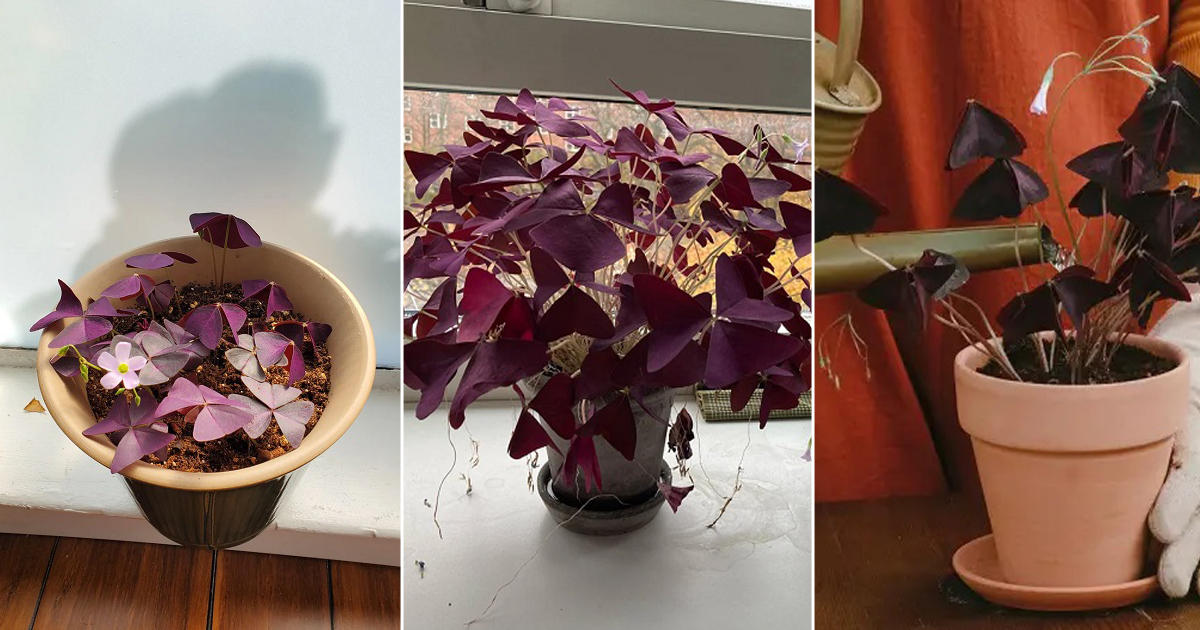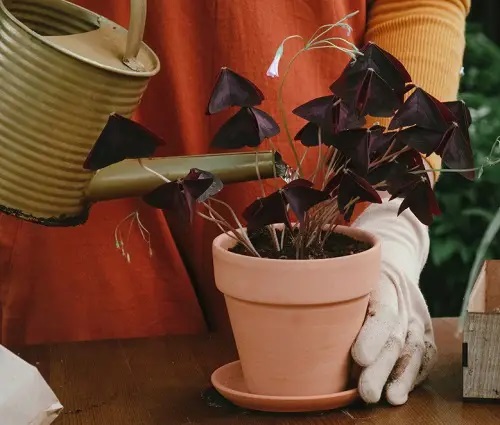Learn How to Grow a Perfect Oxalis on a Windowsill for a beautiful display of attractive, colorful leaves flowing from the pot.

You’ve probably seen pots of oxalis in stores around St. Patrick’s Day, but did you know these plants make great houseplants all year round? If you’ve had one for a while, like your Myke oxalis that’s been thriving on your windowsill for nearly a decade, you know how easy and rewarding they can be.
Oxalis plants are admired for their attractive leaves and nearly constant flowers. The Oxalis family comprises approximately 850 species. Some are garden weeds, while others are delicate plants for rock gardens. However, the best options for indoor use are the tender, bulb-growing types from Mexico and South America. They don’t like cold weather, so you’ll need to bring them inside when the temperature drops. You can also grow them as annuals in flower beds or large pots outside during warm months, then keep them indoors over winter.
There are even some hardy types now, like Oxalis articulata forma crassipes from Japan. These can survive outdoors in Zone 6 and bloom nonstop with white or pink flowers.
Oxalis is often sold as a shamrock or Lucky Charm plant, but it’s not the real Irish shamrock. That title belongs to white clover (Trifolium repens).
Common Names: Love plant, Purple shamrock, False shamrock, Wood sorrel, Black oxalis, Oxalis plant, Shamrock plant
Botanical Name: Oxalis triangularis syn. Oxalis regnellii
USDA Hardiness Zone: 8-11
Propagating Oxalis Plant
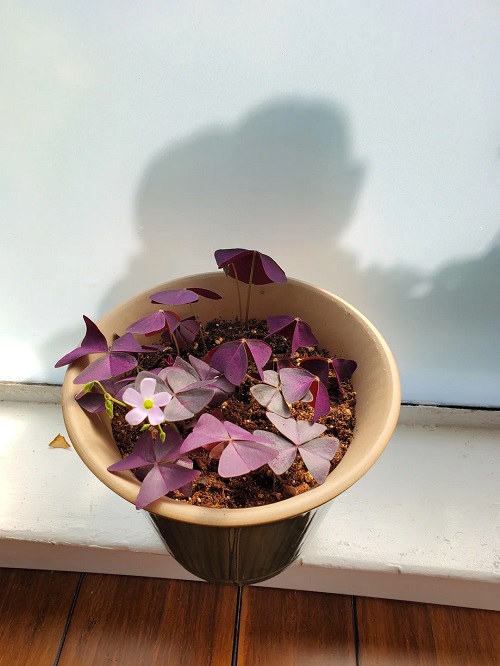
Dividing Your Oxalis
Dividing oxalis is an easy and cheap way to grow more plants. It also helps prevent your plant from getting too crowded.
Start by gently digging up the plant, making sure you don’t damage the roots. If the plant is big, carefully pull the roots apart or cut the root ball into smaller sections using clean scissors.
Then, plant each new piece in fresh, well-draining soil.
Growing Oxalis from Bulbs
Plant oxalis bulbs in spring. If you’re planting more than one, space them about 3 to 4 inches apart. Water the soil lightly—don’t let it get too wet.
Place the pot in a warm, bright spot. You’ll see new leaves start to grow in about 3 to 4 weeks.
Requirements for Growing Purple Shamrock
Light
When growing oxalis indoors, make sure it gets 1 to 2 hours of gentle direct sunlight each day. Keep the pot near a window where it gets bright, indirect light for most of the day.
Turn the plant a little each week so all sides get equal light. If your oxalis doesn’t get enough light, it may stop growing properly.
Soil
Use a loose, well-draining potting mix like loamy or sandy soil made for houseplants. Oxalis roots can rot easily, so don’t use heavy or compact soil.
If you want to make your own mix, combine one part garden soil, one part potting mix, and one part peat or coconut coir.
Water
Shamrock plants don’t like dry soil. They grow best when the soil stays slightly moist, so don’t let it dry out completely or the plant will wilt.
When growing indoors, be careful not to overwater. Since water doesn’t evaporate quickly inside, the roots can rot if the soil stays too wet. It’s best to water when the top inch of soil feels a little dry.
In winter, when the plant is resting, water just a little every 2–3 weeks.
Temperature and Humidity
Oxalis likes a stable, warm temperature. It can handle cool nights as low as 50°F (10°C).
Keep it away from air conditioners, heaters, or cold drafts, as these can damage the leaves.
This plant also likes moderate humidity. If you place it near other houseplants, that will help keep the humidity just right.
Oxalis Plant Care
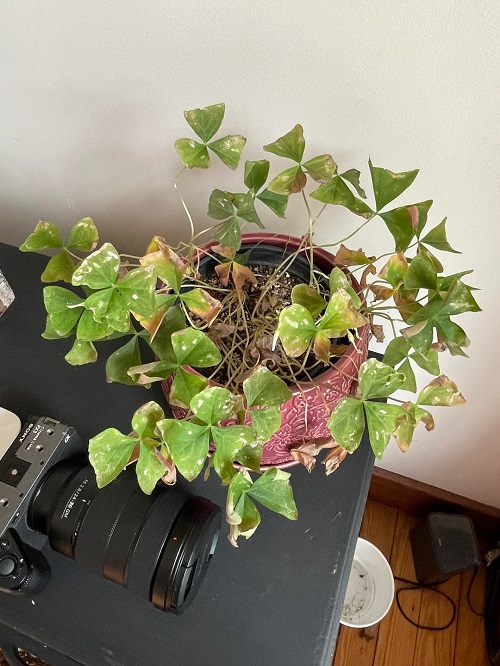
Fertilizer
Feed your purple shamrock with a balanced liquid fertilizer every 4 to 6 weeks. Make sure to dilute it to one-fourth of the recommended strength. Always read the label for proper instructions.
Pests and Diseases
This pretty plant can sometimes get pests like mealybugs, spider mites, and aphids. If you see them, spray the plant with insecticidal soap to get rid of them.
How to Boost Flowering in Oxalis
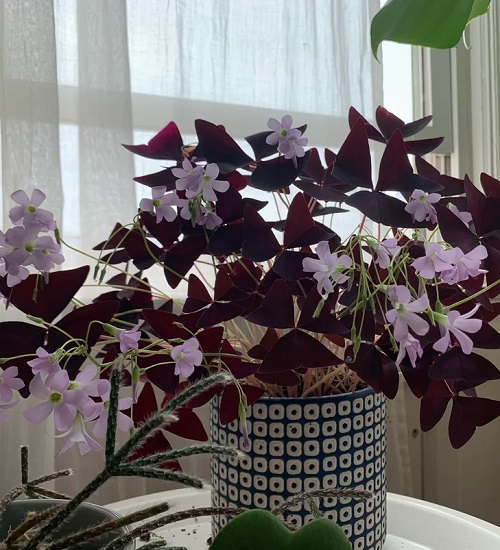
To help your plant bloom, give it filtered sunlight, keep the soil moist, and feed it on time. The purple shamrock usually flowers from fall to spring, producing small, five-petal flowers in clusters above the leaves.
You don’t need to remove the old flowers to make it bloom more, but doing so will keep the plant looking tidy.

